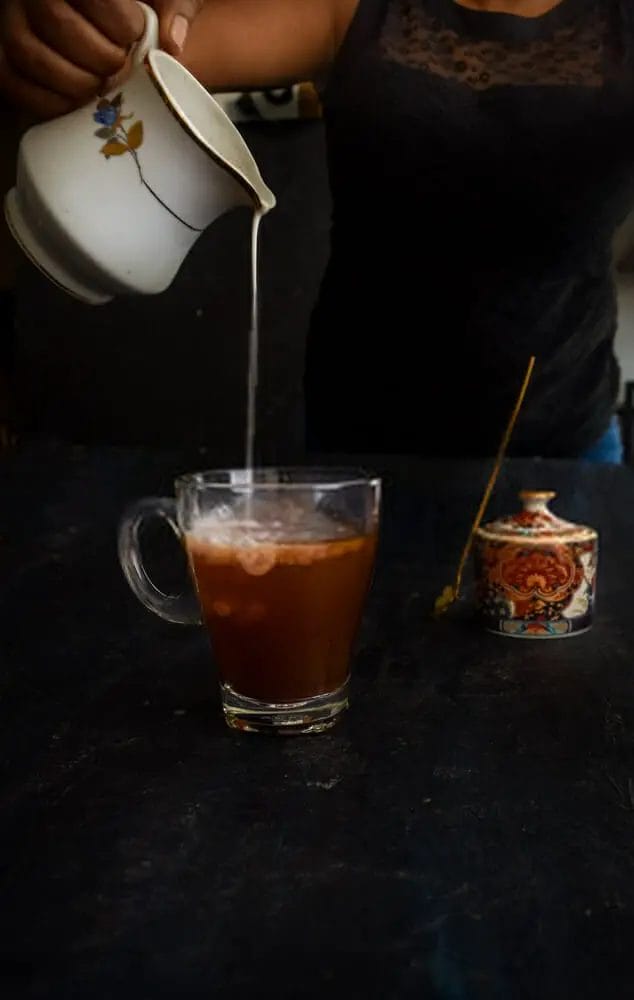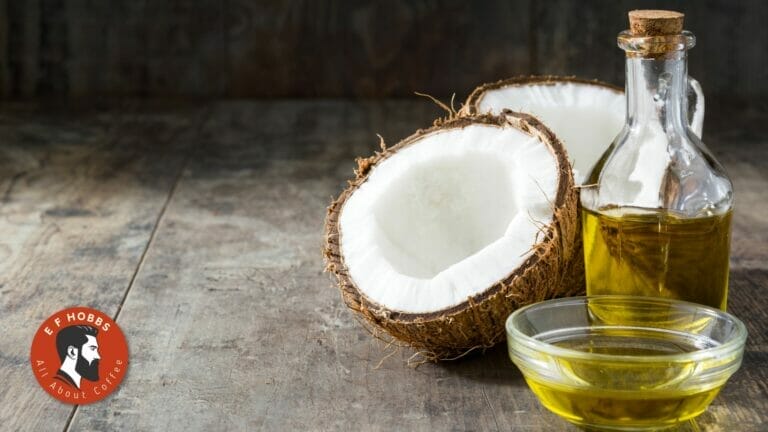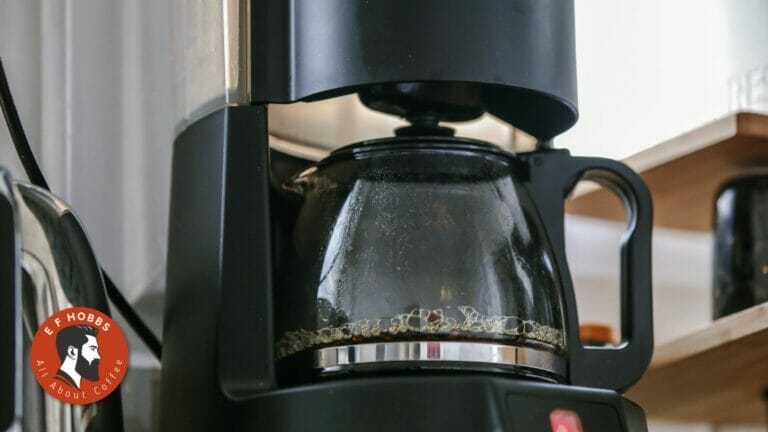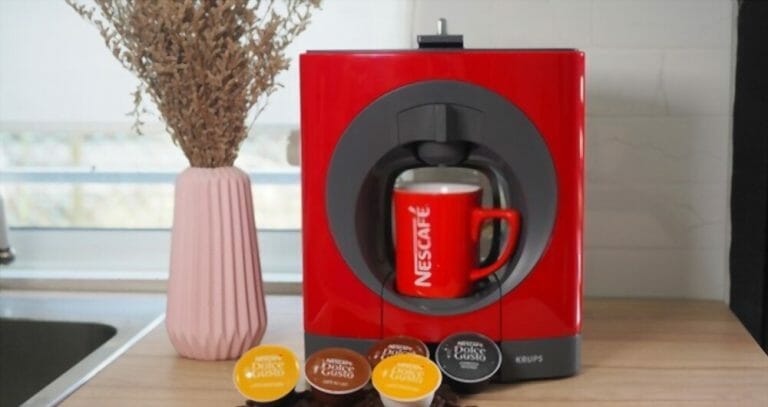Complete Guide To Coffee Brewing Methods
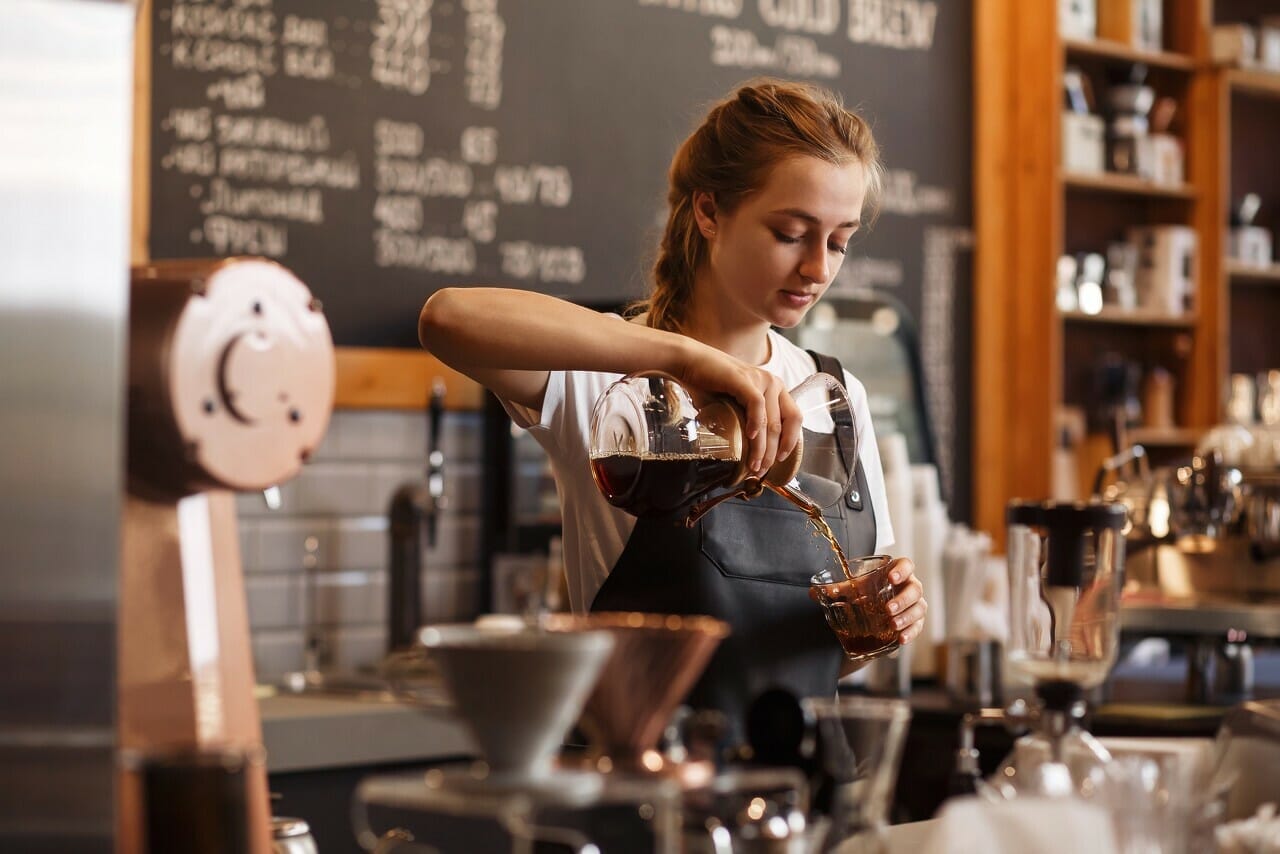
Coffee is a heavenly elixir, which can be enjoyed in an infinite number of ways, whether you are at home or at a cafe.
There are many different ways to brew coffee, you will get a good understanding of all the methods after reading through this guide.
Don’t feel pressured by time limits; take your time and follow what feels comfortable for you!
For many people coffee is just a way to get their daily dose of caffeine. But for others, coffee is a more complex drink that can be brewed in a number of different ways. The brewing process has both an effect on the outcome and also the time required to brew a cup of coffee.
The following article will cover various methods of coffee brewing, from simply adding hot water over ground coffee, to more complicated processes which yield much better results and more exciting flavors.
We have organized the different Brewing methods by how they work: boiling, steeping, dripping, and pressure.
These methods each have their own set of tools, processes, and unique taste profiles. We've also added a few lesser-known methods at the end.
Coffee Brewing Methods – A Quick Summary
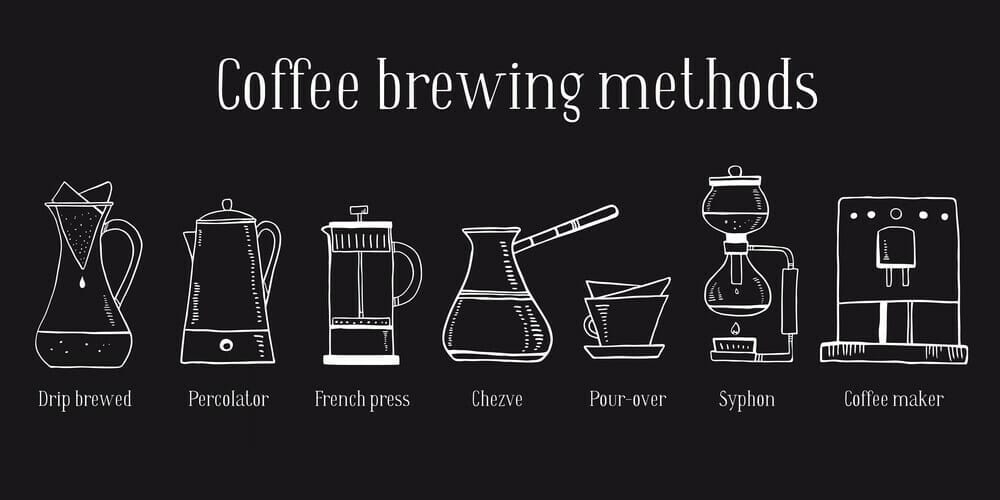
- Boiling Methods-Cowboy coffee, Turkish Coffee
- Steeping Methods-French press, Cold brew coffee, Coffee bags, Siphon brewers, Instant coffee/espresso.
- Dripping Methods-Electric/stovetop percolators, Auto-drip machines, Pour-overs, Specialty pour-overs.
- Pressure Methods-Espresso, Moka pot, AeroPress, Single-serve pod machines.
- Lesser-Known Methods- Vietnamese Phin, Nitrous coffee, Puerto Rican café con Leche
1. Boiling Methods
Boiling Coffee produces a good, strong brew. It may not be the most impressive method, but it is easy to learn.
Fast and easy to do, this is the most common way to brew coffee.
a) Cowboy Coffee
The cowboy coffee brewing method is the simplest type of coffee making. All you need is a pot to boil water and a few filters of coffee grounds.
The Instructions:
- First, pour the hot water into your cup. Then put the grounds in the filter. This guides as much of the flavor through the filter as possible, shaping how your final brew will taste.
- Next, slowly pour some hot water into your pot of ground coffee. Leave a couple of inches of room at the top. Now you’re ready to let your brew steep.
- To steep, you just have to wait for your water to cool down. You can do this by putting it on the countertop, but if you don’t have time to wait, then just pour it in cold water and stir.
- When it’s finished steeping, slowly pour the coffee into your mug/cup of choice.
PROS:
- Easy to brew
- Affordable
- Quick
CONS:
- May end up with grounds in your cup
- Not the best flavor
b) Turkish coffee
A Turkish coffee brewing method is a little more involved than a cowboy coffee. Turkey is an hourglass-shaped country, with the northern coast being so close to Europe that people there drink coffee like they’re in Europe.
A variant of this brewing method often involves cold coffee combined with hot water, but we’ll get to that later on. There are many versions of this method, and each one has its own unique advantages, so we’ll explain how to make them all.
First of all, you'll need to get a kettle and hot water. Pour in some boiling water, let it cool down, then boil some more. The amount of cold water used depends on the strength of the coffee you're brewing.
This method is ideal for rich, strong coffees like espressos or micro-lot blends. For lighter or weaker coffees, use more warm water and less cold water.
Each type of varietal has its own optimum brewing temperature, water-to-coffee ratio and time, so you can follow the instructions of your chosen brand to get the best results.
The Instructions:
- Put your cup or pot on top of a coffee maker with a filter.
- Pour hot water into the filter and let it brew.
- Then carefully add cold water to the cup/pot, but leave enough room for some coffee grounds.
- Let it brew again, then serve. Enjoy.
PROS:
- Simple to brew
- You can use ground coffee
- More coffee flavor CONS:
- Takes a long time to steep (up to an hour)
- You can make the coffee taste bitter by over-steeping
- Could be hard to get a good amount of grounds in the filter
2.Steeping Methods
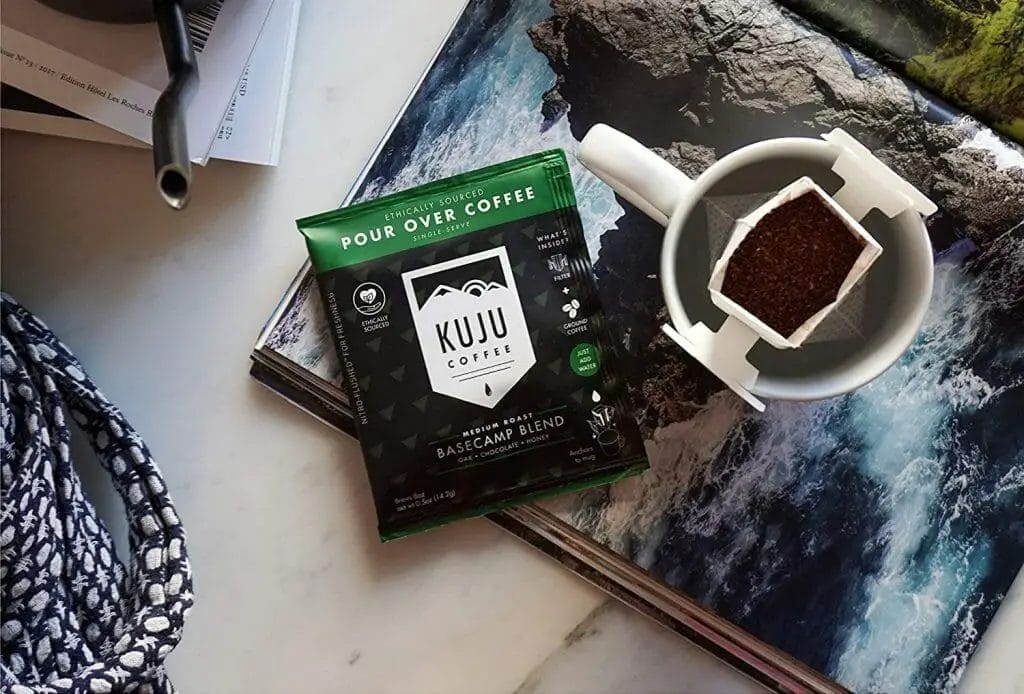
Steeping coffee in hot water is the easiest way to make a cup of coffee, and it is the method that involves the least amount of equipment.
However, there are a few different variations of steeping methods; check out these instructions on how to do them well.
a) French Press
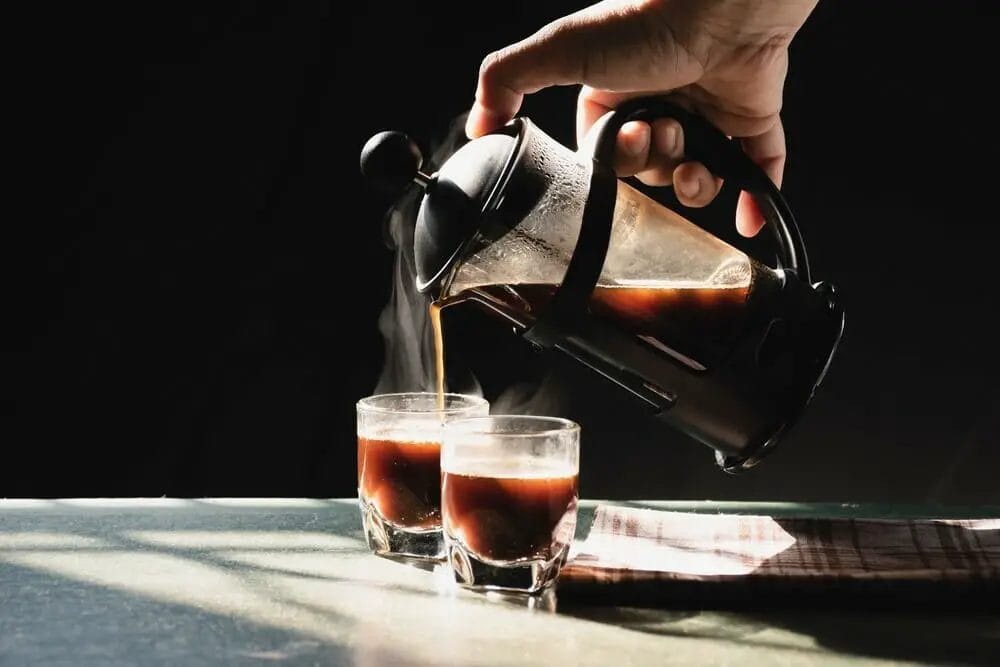
A french press is a simple tool that consists of two main parts: a carafe and a plunger. It’s an easy process that doesn’t require any fancy equipment but still produces great results.
The french press method is also one of the most popular ways to brew coffee in many parts of the world.
The Instructions:
- First off, you need to know what type of beans you are using and what strength you want. This information will help determine the number of coffee grounds and water you need.
- Next, pour your hot water into your carafe, then add your freshly ground coffee to it (make sure that the grounds fall into a little pile at the bottom). Then stir everything together with a spoon.
- Next, slowly plunge the plunger into the brew, making sure to keep the grounds from spilling out. The best way to do this is to hold it at an angle so that the side of the carafe is lower and that you can dip it into your cup/mug.
- Now just let it steep for as long as you like. You can set a timer if you want to be sure that it hasn’t overcooked the drink.
PROS:
- Works for all types of Coffee
- It’s easy
- Produces several cups at once
- You get a full-bodied coffee with a lot of flavors CONS:
- Generally highly textured with sediment
- Can be bitter if left too steep for too long
- Not very portable
Read more about French Press in our Ultimate Guide to French Press Coffee Brewing.
b) Coffee Bags, Caffeinated Ice Cubes and Cold Brew Coffee
There are a few methods of making coffee that involve cooling down hot water to get a cold brew. In theory, cold brewing is the best way to extract flavors out of coffee grounds because heat tends to burn off important oils which give coffee its flavor.
This method is much less common than cowboy coffee and Turkish coffee. It’s a good way to drink coffee if you’re in the mood for something a little darker and richer tasting.
- The first step of cold brewing involves pouring hot water over ground coffees. The second step involves letting the water cool down to room temperature, which takes about 8 hours.
- Once the color of the water changes from clear/blue to an orange tint, it’s ready to be consumed.
- So either drinks it hot or put it in the fridge and drink it cold.
PROS:
- Doesn’t require special equipment
- Cold brew is full-flavored and smooth
- Low acidity and slightly sweet
- Easy to brew
CONS:
- It takes up time to steep (8 hours)
- Takes a lot of coffee grounds to make one batch
c) Siphon brewers
A siphon brewer is a specialized type of coffee maker which involves a two-chambered vacuum tube.
Water in the lower part of the tube heats up and rises up to the top chamber. The hot water is then transferred from the upper chamber through the filter and into your coffee cup.
The best part about this brewing method is that you never have to worry about over-steeping your coffee because it brews it more quickly than most other methods.
The Instructions:
- First of all, place a small filter on the bottom chamber. Then you need to boil some water in your kettle and pour it into the bottom chamber. Let it heat up and eventually vaporize, filling up the bottom chamber with steam.
- Once this process has been completed, add your coffee grounds to a metal basket (the one that comes with your siphon brewer should be fine). Then, pour the hot water into the upper chamber.
- Make sure that your coffee grounds don’t fall into the bottom chamber. When you place the metal basket in place, there should be enough water to just barely sit on top of them. You can also use a stand-up cup to do this. It works and is easier than using a second basket.
- Then close and seal both chambers with your plunger and let it brew until it has finished brewing (usually takes about 10 minutes). The top chamber will start to lose pressure and when you serve it, make sure that you don’t have any coffee grounds in your cup.
PROS:
- Gives a very clean taste without having to worry about over-steeping
- Very impressive
- Very good for brewing in large amounts CONS:
- Expensive and takes up precious space in your kitchen
- Takes a long time to steep (over an hour)
d) Instant coffee/espresso
Instant coffee is a simple version of brewed coffee. It's made by packing dry grounds of finely ground coffees or instant coffee crystals into a cup, adding hot water, and stirring with a spoon until the grounds settle at the bottom. Instant coffee is most often used while camping or for other outdoor situations.
PROS:
- Simple to make
- Takes little time and effort to brew
- It Doesn’t require special equipment CONS:
- Not very flavorful or complex
- Can be bitter
- Overly acidic
- Dried coffee grounds can clump together
3. Dripping Methods
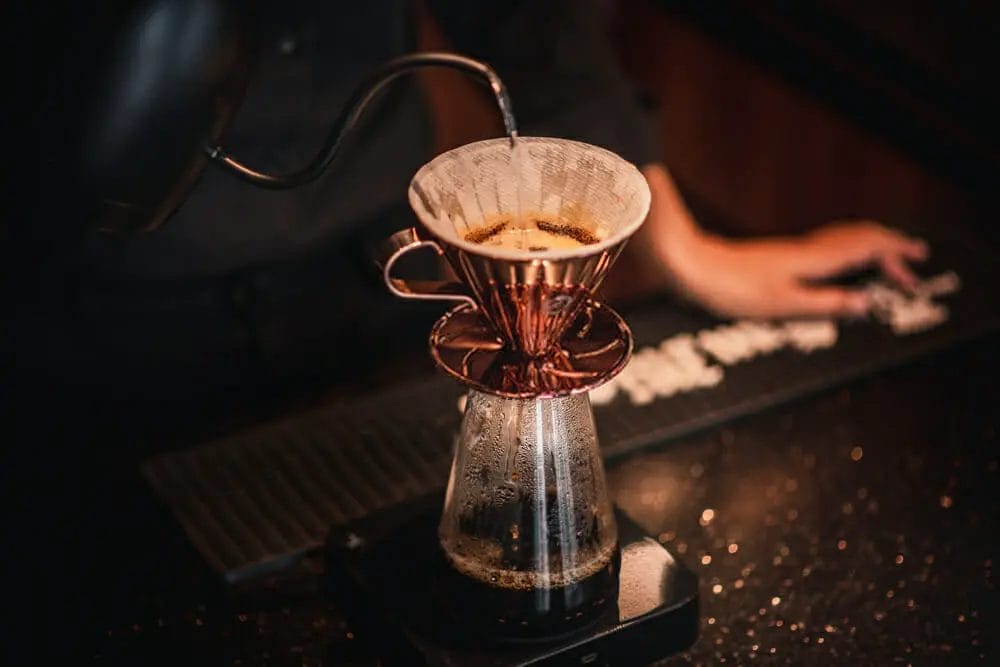
This style of brewing is very popular. Dripping methods involve pouring hot water over coffee grinds and letting the water drip down into a carafe.
Also known as percolation, this method was made popular in the late 19th century. However, it is still very popular today and is widely used in restaurants and professional kitchens over other types of drip machines.
a) Electric/stovetop percolators
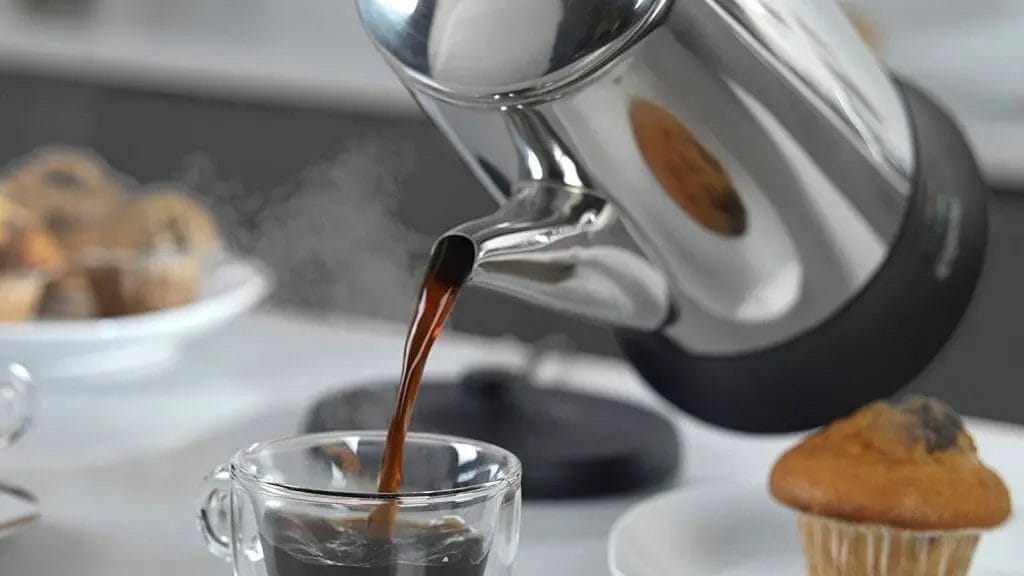
Electric percolators or stovetop percolators are used to make coffee. They are widely used in restaurants and households all over the world.
The removable filter basket allows you to control the amount of coffee and water that goes through it while also allowing you to easily remove it while brewing.
There are no chemicals involved and no need to heat up the process since the hot water is stored in a reservoir.
You simply pour cold water into a heated reservoir and wait for it to perk up before pouring it onto your grounds.
PROS:
- Easy to use
- Produces large amounts of coffee in a short period of time
CONS:
- Can be fragile and easily breakable
- May produce overly bitter or strong coffee
b) Drip filters/Auto-drip machines/Plunger pots

This style of brewing is an old favorite and one that is still somewhat popular today. It was first invented in 1904 by Edward Abbe and is still used by many coffee drinkers around the world.
It requires no special equipment or devices and is so easy to use that even children can use it.
The process involves using a metal mesh sieve to filter the grounds while they are brewing. This is much more efficient than using a paper filter and allows you to extract maximum flavor out of your coffee beans.
PROS:
- Easy to use
- Produces maximum amount of coffee in minimal time
- Very small and minimalistic CONS:
- Hard to brew small amounts
- Coffee grounds can get stuck in the mesh and then not extract properly
c) Pour Overs
Pour-over style brewing is very popular amongst coffee lovers. It features a glass carafe taken directly from an old French press, which has a flexible metal wand once attached.
When the coffee is done brewing, the hot water should be poured straight from the carafe, through and over your grounds without any intervention.
This method puts as much control in your hands as possible and allows you to extract maximum flavor out of your beans.
The pour-over is typically a little more expensive than a standard drip filter machine and results in a stronger flavor.
PROS:
- Allows you to add as much or little coffee grounds as you wish, without any hassle
- Very good at extracting maximum flavor out of your beans
- Produces clear coffee without sediment or natural oils
- Low cost
- Fast brew time
CONS:
- Generally have to buy paper filters
- Can’t make multiple cups at a time
- Paper filters may alter the flavor
d) Specialty pour-overs
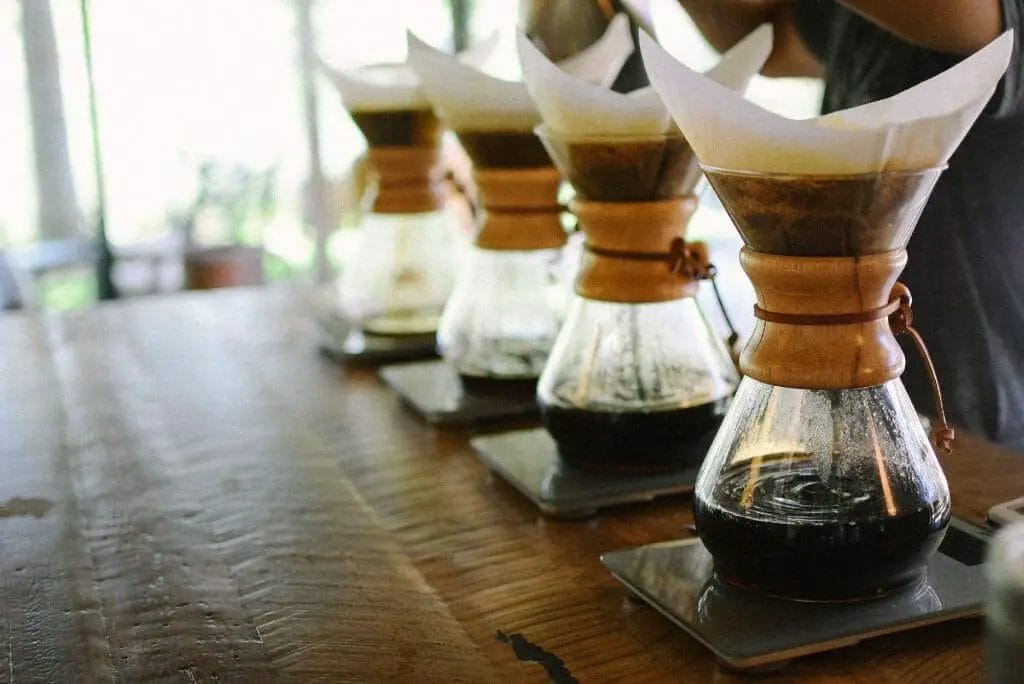
Specialty pour-overs are excellent for making drinks that need to be very concentrated. This is one of the most popular ways to make coffee because it allows you to maximize your coffee bean butter.
At its basic level, this is simply a pour-over where you use more finely ground coffee grounds.
This method is especially good when you want the flavor and caffeine kick but in a smaller amount than using a normal pour-over.
These specialty pour-overs are typically found in cafes and restaurants and are typically made with very finely ground beans.
PROS:
- Allows you to extract maximum flavor without producing too much
- Low cost
- Easy to use
CONS:
- Not efficient if trying to make multiple cups at a time
- Have to buy paper filters
- Paper filters may alter the taste
For more about Pour Over Coffee Brewing read our Detailed Guide to Pour Over Coffee.
4. Pressure Methods
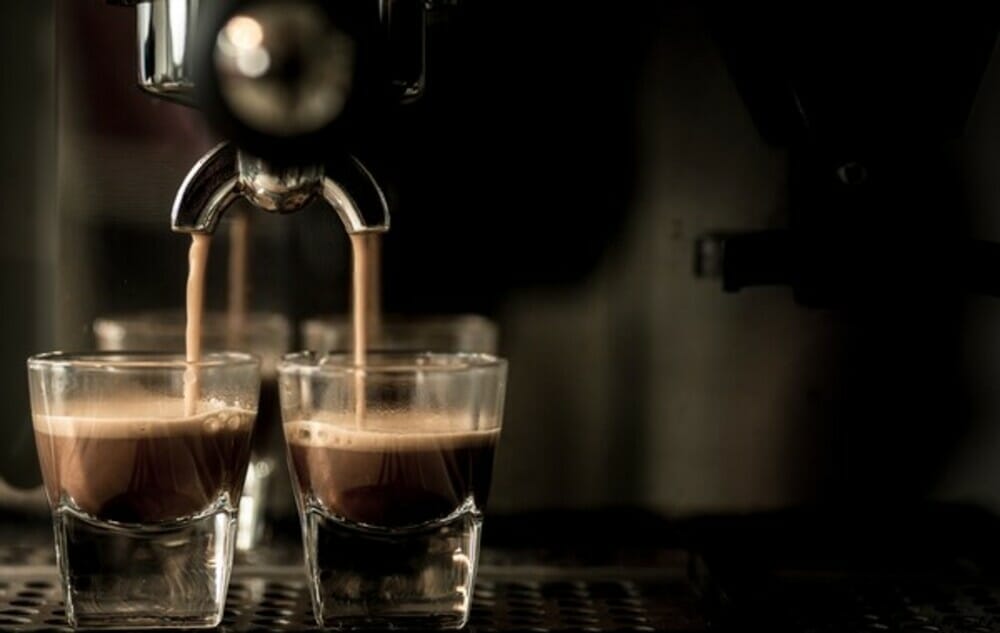
Pressure methods are most commonly used to make coffee. They require a machine that utilizes pressure and force to make your coffee.
These machines can also be called piston brewers, pump-driven espresso makers, or lever machines. All of these produce coffee under high pressure, which results in a stronger flavor and more crema on the surface of the finished brew.
a) Espresso machines
Espresso machines are very popular in restaurants and cafes all over the world. They are also used a lot in households too.
Espresso machines are used to create a very small amount of coffee, usually less than one cup, and require the use of finely ground beans.
As the name of the appliance states, espresso is made by forcing extremely hot water under pressure through fine coffee grounds.
This produces a small amount of extremely strong coffee. This is unique to espresso machines and is not accomplished with other types of pressure brewing methods.
PROS:
- Produces high-quality drinks that are rich and flavorful
- Have varying levels of automation
- Allow control over the brewing process
- Produces strong, full-bodied coffee with crema
CONS:
- Expensive for the amount of coffee produced
- Takes many steps to make a single cup
- Can be difficult to clean or repair if it breaks
b) Moka pot
Moka pots are traditionally made by Luigi De Ponti, an Italian designer, in the mid-1930s. These were originally designed for making coffee on boats and trains, which lacked easy access to electricity but did have access to water. It is now used by many coffee lovers all over the world.
The process of a Moka pot is simple. It produces small amounts of strong coffee through steam pressure, forcing it through a filter and through tightly packed coffee grounds into your cup. Ideally, you brew the coffee with hot water at first so that it has time to cool down before brewing.
PROS:
- Fairly easy to operate
- Lower cost
- Fast brewing
- Produces flavorful coffee
CONS:
- Hard to clean or repair if it breaks
- Low production yields
- Not good for making multiple cups of coffee
c) AeroPress
The AeroPress was invented by Alan Adler and is one of the most simple methods of brewing coffee. This coffee brewer is a combination between a French press and a siphon brewer, combining the best qualities of both systems into one unique device.
The AeroPress works the same as a French press, extracting coffee by pushing hot water through finely-ground coffee grounds.
However, this device uses the same principle as a siphon brewer; rather than using hot water directly, which is poured over the grounds, the water is pushed through a filter into your cup.
The difference between a siphon brewer and an AeroPress is that rather than use physical pressure to force coffee out of the pot. It uses a vacuum to pull it out of the pot.
The AeroPress is very simple to use and requires no filters or coffee grounds. It also requires no electricity, making it great for camping or hiking trips.
This method has a very small learning curve and produces the most flavorful cups of coffee. This device is a favorite among many people who enjoy espresso coffee but don’t want to spend the money on professional-grade equipment.
PROS:
- Easy to use and produce high-quality drinks
- Fairly low cost
- Extremely fast brewing
- Excellent durability and reliability
- Easy to clean or repair if it breaks
CONS:
- Might take up a lot of space on your countertop
- Requires specialized equipment
- Have to buy special paper filters
Read our Most Comprehensive Guide to Aeropress Coffee for All Things Aeropress
d) Single-Serve pod machines
Single-serve pod machines are rapidly becoming a popular way to make coffee in homes and offices.
These machines come in a variety of shapes, sizes, and styles. All of them use a pod with compressed coffee grounds sealed into it to brew the coffee.
This allows one person to create different drinks easily by using different pods. They do not produce as much crema as espresso machines or French presses but can produce decent-quality coffees with great convenience.
- To brew, you simply put water into the machine, place the pod into the port, and push a button.
- This will then pressurize it and release the water through the ground coffee, creating your coffee.
- You can then drink immediately or pour over ice for a cold brew.
PROS:
- Quick and easy to use
- Produces tasty Coffee
- Low cost
- Allow customization of the Coffee
- Fast brewing time period
CONS:
- Can produce strange flavors
- Have to buy pods and grounds separately
- No way to control how much coffee is brewed or how strong it is
5. Lesser-Known Methods
There are many different methods of making coffee that is less commonly used but is still very popular. If you’re a coffee drinker looking for new ways to brew the perfect cup, try these methods!
a) Vietnamese Phin
The Vietnamese Phin is a unique and less traditional method of brewing coffee.
These brewers are small in size and inexpensive. They are used to make Vietnamese coffee. The coffee is mixed with sweetened condensed milk. They prepare one cup of dark, refined coffee at a time.
The phin is a cone-shaped filter. You put ground coffee in the bottom of the cone, cover it with the perforated metal lid, and pour hot water over it. Because of the grounds and heat taking time to steep, the coffee should take about 10 minutes to drip.
Grind size: Coarse, to avert sediment in the base of your vesselPROS:
- Low Cost
- Fairly easy to use and produce high-quality drinks
- Fairly portable
- Reusable filters
CONS:
- Takes time to make the Coffee
- Requires special equipment
- May leave sediment in your cup
b) Nitrous Coffee
Nitrous and nitrogen are both gases that make the base of the coffee taste sweet. The most common method by which nitrous or nitrogen-based gas is used to brew a cup of coffee is by using a combination of gas and water pressure. This produces a rich, creamy setting for the bitter taste.
There are several ways you can use the same principle to create espresso-style coffee. For example, you can use the same basic procedure to pressurized CO2 into the water in order to create an espresso shot.
The difference is that the brew is mixed with more water and passed through a series of filters to produce a stronger brew of sweetened coffee.
PROS:
- Easy to use and produce high-quality drinks
- Fairly cheap
- Great for people who drink lots of coffee
CONS:
- May not produce a great amount of crema
- Difficult to make at home
- Can be expensive
c) Puerto Rican café con leche
This traditional Latin American way of preparing coffee will produce a more mild, sweeter cup of coffee. It is very popular in many countries and is the most popular way to consume cappuccino.
To make this delicious beverage, start by brewing finely ground coffee beans in water. Once it's steeped, Pour a coffee through a colander.
A triangular-shaped wooden holder draped with a cloth filter. To wrap it up, add hot milk to the coffee in a one-to-one ratio.
PROS:
- Easy to use and produce high-quality drinks
- Fairly low cost
3.Produces sweet, creamy, and smooth Coffee - Uses a unique but simple process
CONS:
- Takes a lot of time and requires special equipment
- May leave sediment in your cup
What coffee brewing method should I use?
Now that you’ve got a better idea of how coffee is made, you may be wondering which way is the best to brew your coffee.
Each method has its own positive and negative qualities. However, we generally recommend the French press and AeroPress for most people.
For convenience, we think you should choose the French press if you’re looking for a more traditional way to enjoy your cup of coffee in the morning.
Which brewing method makes the strongest coffee?
The French press produces a very strong and bitter coffee. The AeroPress has a unique method of brewing coffee that produces a more delicate, mild-tasting cup of coffee.
What is immersion coffee brewing?
The immersion method is used to brew a cup of coffee by soaking it in water. This method is most often used with the French press.
What is the best ratio for coffee to water?
To create the optimal brewed coffee, you should follow the ratio of 1:1 (cups to cups). For example, if you have 4 cups of water and 5 cups of ground coffee, the ratio is 1:1.
Which coffee brewing method takes the longest?
The French press is the slowest brewing method of the 4 discussed. It takes at least 4 minutes to steep and another 5 minutes for the coffee to cool slightly.
How many coffee brewing methods are there?
There are many different ways of making coffee. Each method produces a different taste and strong brew. But, there are four main ways of brewing coffee. These are Infusion, decoction, percolation, and immersion.
Which coffee brewing method is most efficient?
The Coffee machine is the most efficient coffee brewing method because it takes little to no time at all.
The AeroPress is the least efficient because it takes longer than using any of the other methods. If you want to make 10 cups of coffee, it will take you approximately 30 minutes to brew your morning cup!
Is French press or drip coffee better?
The taste of the coffee depends on the beans you use, but most prefer a French press because it gives you a more personal brew of coffee.
How do you make old fashioned coffee?
To make old-fashioned coffee, which is still popular in South Africa, use a fireplace and a cast iron pot.
Which coffee method has most caffeine?
The coffee machine or percolator will make the most caffeine of all methods.
What is the difference between brewing and fermenting?
The brewing process is just what it sounds like: brewing coffee based off of the amount of water that you put in. The fermenting process starts with a chemical change in the coffee beans and determines their strength.
What coffee gives you the most energy?
Coffee contains some powerful chemicals that can give you energy. Of all types of coffee produced, the most caffeine is found in arabica beans. The strongest energy will come from a shot of espresso, especially if you add some sugar to it.
Can I make coffee without a filter?
It is possible to make coffee without a filter, but it is fraught with many problems. Without a filter, you run the risk of having coffee grounds make their way into your cup. It’s best to just buy a reusable filter and make sure that everything is as clean as possible.
Conclusion:

If you’re ready to brew your own coffee at home, try some of the methods we mentioned above. The AeroPress, French press, and single-serve pod machines are our top picks for at-home brewing.
If you want to have a delicious cup of coffee every time, we suggest using these methods. If you're looking for an easy way to make the perfect cup, then we recommend using a single-serve pod machine.
If you want something that brews a larger amount of coffee at once, such as for a party or office setting, try using the AeroPress, French press, or single-serve pod machines.
We would especially recommend these options if you are brewing for more than just one person. If you're making coffee for a group, then you can save time and money by brewing all at once.
Finally, if you’re looking for something that is easy and makes a good amount of coffee, try using a single-serve pod machine. They are easy to use and require little to no cleanup.
These machines could also be a good choice if you want to travel with your coffee or have trouble brewing the perfect cup at home.

